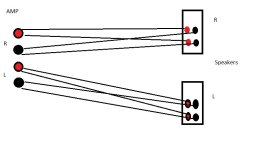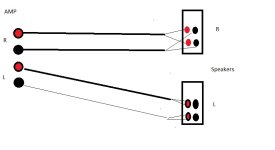NorthStar
New member
You guys are really going to force me to try this aren't you? LOL
What the heck...keeps me off the streets so I don't harass people...:reallymad:
What's up Rob?
You guys are really going to force me to try this aren't you? LOL
What the heck...keeps me off the streets so I don't harass people...:reallymad:
Maybe the degree of difference has something to do with the impedance of the speaker? Or perhaps the sensitivity of the speaker.
I know for sure that bi-wiring did not only audibly improve the sound of my 83db inefficient 3 ohm Apogee Duetta Sig's, but it's damn near essential to make them sound their best. Perhaps it's just the added gauge summing the 2 together to deliver the extra power they need?
As I've tried over the years to bi-wire systems. It appears that the speaker crossover is what determines whether it is beneficial or detrimental to the sound.
I would say that probably 75% of the time that using the exact same type of speaker cable to bi-wire a system it did not improve the sound. Most of the time, it degraded the "rhythm and pace" of the music.
But the bottom line is - it does make a difference, sometimes good, sometimes not so good.
Maybe the degree of difference has something to do with the impedance of the speaker? Or perhaps the sensitivity of the speaker.
I know for sure that bi-wiring did not only audibly improve the sound of my 83db inefficient 3 ohm Apogee Duetta Sig's, but it's damn near essential to make them sound their best. Perhaps it's just the added gauge summing the 2 together to deliver the extra power they need?


Caelin,
explain something for me. How is diagram one any better than diagram 2 ? Diagram 2 is how many BI-WIRE cables are sold. If I used 4 separate wires per speaker, they are still all going to carry the same signal yes ? So it would be irrelevant to have to separate all 4 wires Or is the driver draw what dictates the path of least resistance so to speak ? Just not clear...Thanks
View attachment 4483
View attachment 4484
If you do chose to bi-wire a speaker these are some general guidelines that I follow:
1) The two runs of wire should be separate through the entirety of the length of the cable. This means that the high/mid and the low conductor should each be separate starting at the amplifier speaker terminals.
2) The high/mid and the low conductor should be the same size in gauge and of the same geometry and conductor type. Identical.
3) The conductors should be the same length.
4) The positive and negative conductors should be the same size - not different as is done in some designs.
Caelin Gabriel
President
Shunyata Research
Good day Caelin,
1. Wow, what to do what to do now, according to what you just said above?
Here's what I do right now: I'm using one run of KimberKable 8TC to bi-wire my center speaker channel (with two sets of binding posts). At the amp's end I use only one set of binding post. I split 5 wires going to the woofer/mid's section and the remaining 3 wires to the tweeter section.
So all 8 wires (twisted together) from the amp, and split just like I described at the speaker's end (the last six inches or so).
The two runs of wires at the speaker's end are one single run (8TC) all the way to the amp. ...So, no separation to speak of.
Any thought? ...General thought.
2. Of course that way I gave the low/mids 5 wires (more gauge) than the tweeter only 3 wires (less gauge).
- Geometry is same and so is conductor type, of course. ...Identical.
Same as number one above, any thought?
3. All good here; same exact length. ...2 meters (roughly six feet).
4. Good here too; same number of wires for the Positive and Negative of each driver section; amp's terminals (+8/-8), and speaker's terminals - lows (+5/-5) & highs (+3/-3).
Hopefully my post is clear enough, and I'm very anxious to read your reply.
Very best regards, and it is a privilege to have you aboard.
<<>> Amp is a SS high current (AB) design (200W+). And the speaker is roughly 89dB efficient (sensitivity at one meter - in-room),
and with a minimum of 2.8Ω impedance @ 200Hz (or below 3Ω between roughly 100Hz and 300Hz).
And the phase is reasonable/coherent throughout most of the midrange (lowest point is @ 70Hz, which is -45°).
One last thing; for multichannel music I sometimes run it full range (-6dB @ 30Hz).
And for movies I send the lows (below 80Hz) to the subs.
